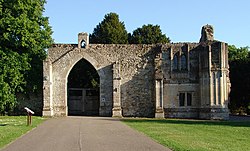
Huntingdonshire is a local government district of Cambridgeshire and a historic county of England. The district council is based in Huntingdon. Other towns include Godmanchester, Kimbolton, Ramsey, St Ives and St Neots. The population was 180,800 at the 2021 Census.

Ramsey Abbey was a Benedictine abbey in Ramsey, Huntingdonshire, England. It was founded about AD 969 and dissolved in 1539.

Huntingdon and Peterborough was a short-lived administrative and geographical county in East Anglia in the United Kingdom. It existed from 1965 to 1974, when it became part of Cambridgeshire.

Ramsey is a market town and civil parish in the Huntingdonshire district of Cambridgeshire, England. The town is about 9 miles (14 km) north of Huntingdon. Ramsey parish includes the settlements of Ramsey Forty Foot, Ramsey Heights, Ramsey Mereside, Ramsey Hollow and Ramsey St Mary's.

Houghton Mill is a water mill located on the Great Ouse in the village of Houghton, Cambridgeshire, England. It is a National Trust property and a Grade II* listed building.

Abbots Ripton is a village and civil parish in Cambridgeshire, England. Abbots Ripton is situated within Huntingdonshire which is a non-metropolitan district of Cambridgeshire as well as being an historic county of England. Abbots Ripton lies approximately 4 miles (6 km) north of Huntingdon on the B1090.

Yelling is a linear village and civil parish in the Huntingdonshire administrative district of Cambridgeshire, England. The village is about 5 miles (8 km) east of St Neots and 6 miles (10 km) south of Huntingdon.
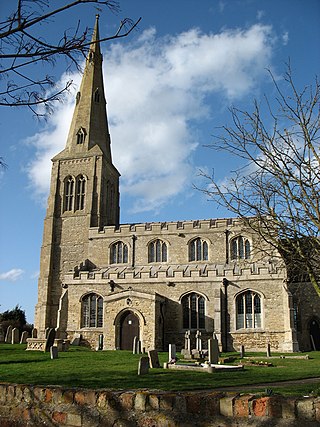
Ellington is a village and civil parish in Cambridgeshire, England, 4 miles (6 km) west of Huntingdon in Huntingdonshire, a non-metropolitan district of Cambridgeshire and historic county of England. The civil parish covers an area of 2,700 acres ; much of it is grassland with some small woods in the south of the parish.
Huntingdonshire was a Parliamentary constituency covering the county of Huntingdonshire in England. It was represented by two Members of Parliament in the House of Commons of England until 1707, then in the House of Commons of Great Britain from 1707 to 1800, and then in the House of Commons the Parliament of the United Kingdom from 1801 to 1885.
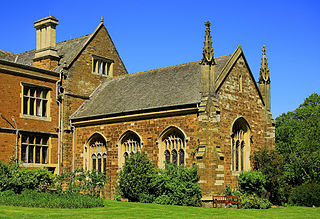
Launde Abbey is located in Leicestershire, England, 14 miles east of the city of Leicester and 6 miles south west of Oakham in Rutland. The house was built on the site of the Augustinian Launde Priory. The Grade II* listed building is predominantly used as a conference and retreat centre by the Church of England dioceses of Leicester and Peterborough.

The de Grey Mausoleum in Flitton, Bedfordshire, England, is one of the largest sepulchral chapels in the country. The mausoleum contains over twenty monuments to the de Grey family who lived in nearby Wrest Park.

Lyddington Bede House is a historic house in Rutland, England, owned and opened to the public by English Heritage. The existing Grade I listed building is a part of a former palace of the Bishops of Lincoln, later used as an almshouse. It is next to St Andrew's Church in the village of Lyddington. The watch tower or gazebo is separately listed as Grade I and the boundary walls are Grade II. The site is a scheduled monument.
The Grade I listed buildings in Cheshire, excluding those in the city of Chester, total around 80. Almost half of these are churches that are contained in a separate list.

Saighton Grange originated as a monastic grange. It was later converted into a country house and, as of 2013, the building is used as a school. It is located in Saighton, Cheshire, England. The only surviving part of the monastic grange is the gatehouse, which is recorded in the National Heritage List for England as a designated Grade I listed building, and is one of only two surviving monastic manorial buildings in Cheshire, the other being Ince Manor. The rest of the building is listed at Grade II, as is its chapel.

Sawtry Abbey was a Cistercian abbey located between Sawtry and Woodwalton in Cambridgeshire, England. The abbey was founded in 1147 by Simon II de Senlis, Earl of Northampton, who was the grandson of Earl Waltheof and Judith, the niece of William the Conqueror who held the manor when the Domesday Survey was compiled. It is the only Cistercian abbey in the county.
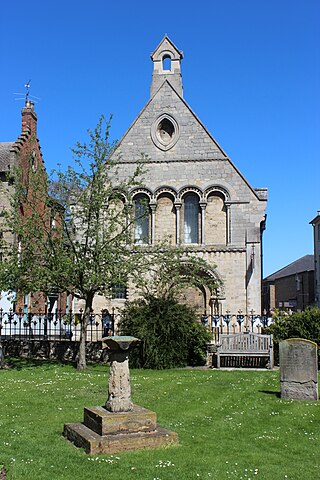
The Cromwell Museum in Huntingdon, England, is a museum containing collections exploring the life of Oliver Cromwell and to a lesser extent his son Richard Cromwell. Oliver Cromwell was born in Huntingdon in 1599 and lived there for more than half his life. The museum is located in the former grammar school building in which Cromwell received his early education. Founded in 1962, the museum contains significant artefacts, paintings and printed material relating to The Protectorate. The museum is currently run as part of a trust dedicated to Oliver Cromwell's legacy and previously by the Cambridgeshire Libraries, Archives and Information Service, part of Cambridgeshire County Council.
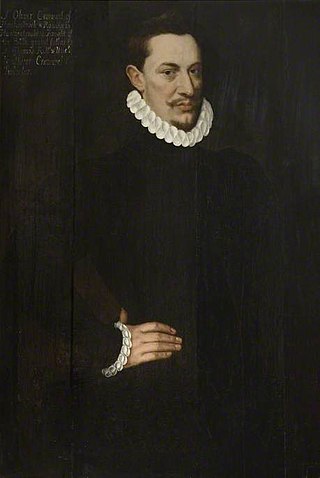
Sir Oliver Cromwell was an English landowner, lawyer and politician who sat in the House of Commons at various times between 1589 and 1625. He was the uncle of Oliver Cromwell, the Member of Parliament, general, and Lord Protector of England.
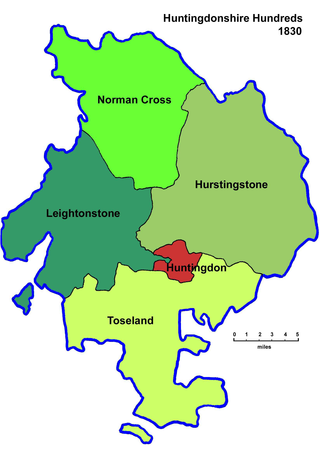
Hurstingstone was a hundred of Huntingdonshire, England that was mentioned in the Domesday Book of 1086.

The Church of St Thomas à Becket, Ramsey is the Church of England parish church of Ramsey, Cambridgeshire. The parish is part of a benefice that includes also the parish of Upwood with Great and Little Raveley.
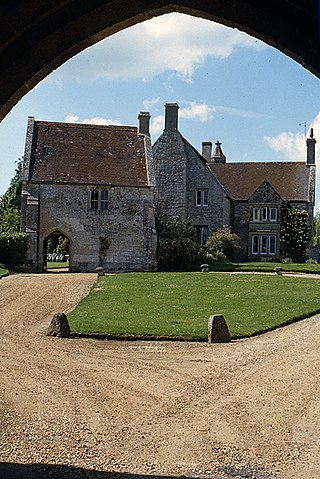
Place Farm is a complex of medieval buildings in the village of Tisbury, Wiltshire, England. They originally formed a grange of Shaftesbury Abbey. The farmhouse, the inner and outer gatehouses and the barn, reputedly the largest in England, are all Grade I listed buildings.
